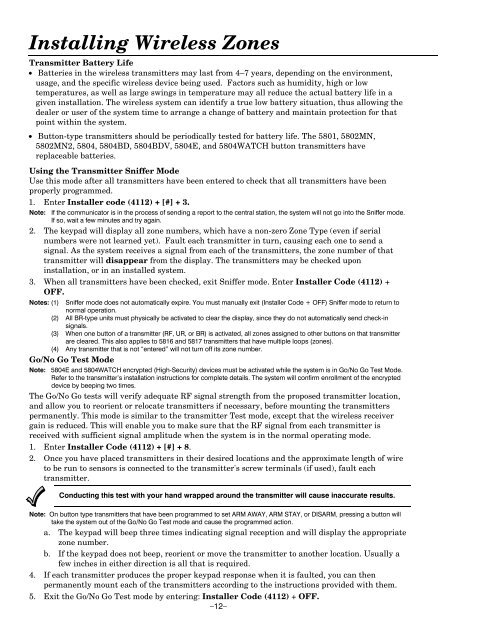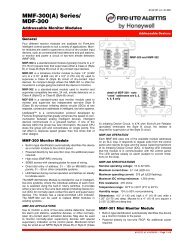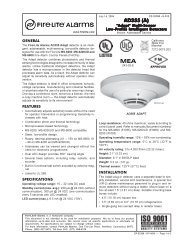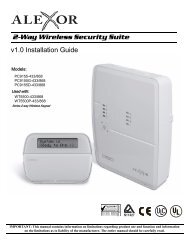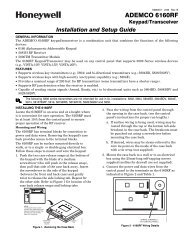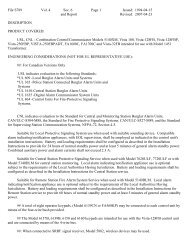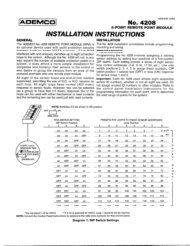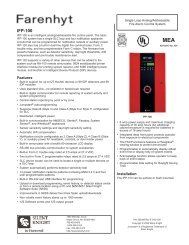ADEMCO LYNXR Series Security Systems - Patriot Alarm Systems ...
ADEMCO LYNXR Series Security Systems - Patriot Alarm Systems ...
ADEMCO LYNXR Series Security Systems - Patriot Alarm Systems ...
You also want an ePaper? Increase the reach of your titles
YUMPU automatically turns print PDFs into web optimized ePapers that Google loves.
Installing Wireless Zones<br />
Transmitter Battery Life<br />
• Batteries in the wireless transmitters may last from 4–7 years, depending on the environment,<br />
usage, and the specific wireless device being used. Factors such as humidity, high or low<br />
temperatures, as well as large swings in temperature may all reduce the actual battery life in a<br />
given installation. The wireless system can identify a true low battery situation, thus allowing the<br />
dealer or user of the system time to arrange a change of battery and maintain protection for that<br />
point within the system.<br />
• Button-type transmitters should be periodically tested for battery life. The 5801, 5802MN,<br />
5802MN2, 5804, 5804BD, 5804BDV, 5804E, and 5804WATCH button transmitters have<br />
replaceable batteries.<br />
Using the Transmitter Sniffer Mode<br />
Use this mode after all transmitters have been entered to check that all transmitters have been<br />
properly programmed.<br />
1. Enter Installer code (4112) + [#] + 3.<br />
Note: If the communicator is in the process of sending a report to the central station, the system will not go into the Sniffer mode.<br />
If so, wait a few minutes and try again.<br />
2. The keypad will display all zone numbers, which have a non-zero Zone Type (even if serial<br />
numbers were not learned yet). Fault each transmitter in turn, causing each one to send a<br />
signal. As the system receives a signal from each of the transmitters, the zone number of that<br />
transmitter will disappear from the display. The transmitters may be checked upon<br />
installation, or in an installed system.<br />
3. When all transmitters have been checked, exit Sniffer mode. Enter Installer Code (4112) +<br />
OFF.<br />
Notes: (1) Sniffer mode does not automatically expire. You must manually exit (Installer Code + OFF) Sniffer mode to return to<br />
normal operation.<br />
(2) All BR-type units must physically be activated to clear the display, since they do not automatically send check-in<br />
signals.<br />
(3) When one button of a transmitter (RF, UR, or BR) is activated, all zones assigned to other buttons on that transmitter<br />
are cleared. This also applies to 5816 and 5817 transmitters that have multiple loops (zones).<br />
(4) Any transmitter that is not “entered” will not turn off its zone number.<br />
Go/No Go Test Mode<br />
Note: 5804E and 5804WATCH encrypted (High-<strong>Security</strong>) devices must be activated while the system is in Go/No Go Test Mode.<br />
Refer to the transmitter’s installation instructions for complete details. The system will confirm enrollment of the encrypted<br />
device by beeping two times.<br />
The Go/No Go tests will verify adequate RF signal strength from the proposed transmitter location,<br />
and allow you to reorient or relocate transmitters if necessary, before mounting the transmitters<br />
permanently. This mode is similar to the transmitter Test mode, except that the wireless receiver<br />
gain is reduced. This will enable you to make sure that the RF signal from each transmitter is<br />
received with sufficient signal amplitude when the system is in the normal operating mode.<br />
1. Enter Installer Code (4112) + [#] + 8.<br />
2. Once you have placed transmitters in their desired locations and the approximate length of wire<br />
to be run to sensors is connected to the transmitter's screw terminals (if used), fault each<br />
transmitter.<br />
Conducting this test with your hand wrapped around the transmitter will cause inaccurate results.<br />
Note: On button type transmitters that have been programmed to set ARM AWAY, ARM STAY, or DISARM, pressing a button will<br />
take the system out of the Go/No Go Test mode and cause the programmed action.<br />
a. The keypad will beep three times indicating signal reception and will display the appropriate<br />
zone number.<br />
b. If the keypad does not beep, reorient or move the transmitter to another location. Usually a<br />
few inches in either direction is all that is required.<br />
4. If each transmitter produces the proper keypad response when it is faulted, you can then<br />
permanently mount each of the transmitters according to the instructions provided with them.<br />
5. Exit the Go/No Go Test mode by entering: Installer Code (4112) + OFF.<br />
–12–


